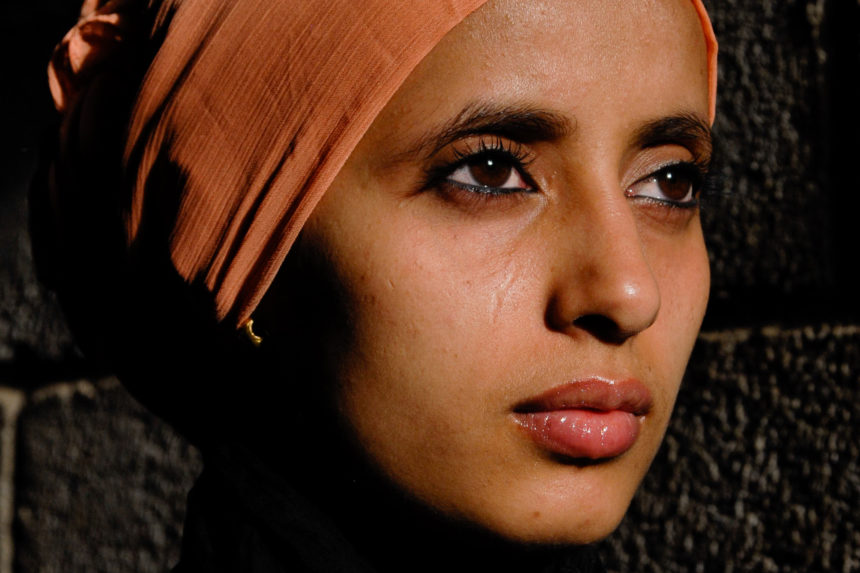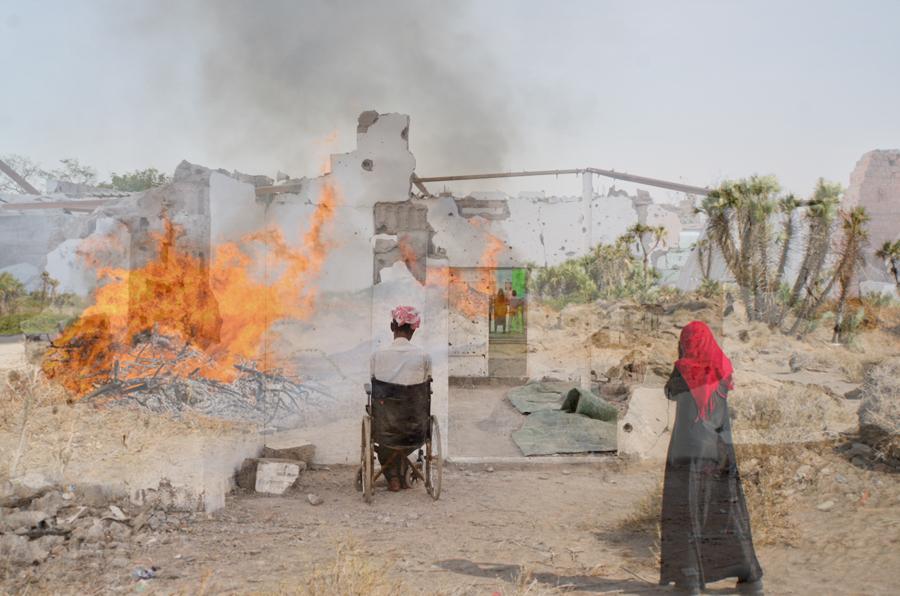In 2011 Amira Al-Sharif became the first female to capture Yemen’s revolution as it happened. Her latest series, however, pieces together those brief moments of freedom with today’s horrifying realities, giving faces and voices to Yemen’s women.
May 17,2015
Amira Al-Sharif can’t hold her tears as she reads her sister’s message. “At 2:30 am I saw the world turn red because of the explosion. Khalas, we almost go crazy, we went to the street with no clothes, it was all in rubble and we could not see anything. Then we drove with the lights turned off so that the planes would not see us and fire at us.” Stranded in Sweden as Yemen’s airports have been hit by airstrikes, the photojournalist witnesses the destruction of the country she thoroughly documented, now at a heartbreaking distance.
“Both my sisters lost their houses in the first air strike to Sanaa Airport and had to move to nearby villages, but all their neighbours died. My parents are still in Sanaa; they know it is not safe but they have no other option,” she tells us in an interview from Eskilstuna, where she flew after exhibiting her photographs in Cambodia.
Since the Saudi-led coalition began air strikes in Yemen last March 26th, 1,500 civilians have been killed, 6,200 were injured, and 300,000 were forced to flee their homes, according to UNOCHA. “The Saudi government has destroyed all airports, so there is no aid reaching out,” explains Al-Sharif. Due to the lack of petrol and transportation, there is a dramatic food and water shortage, and traveling to seek refuge is nearly impossible. “So everybody is stuck,” she says with a sigh.
“This was my first picture after my return from New York, of the clashes between the armed division related to Ali Muhsen and security forces in Kintaki, in September 2011. The woman is me in the old city, watching the destruction from afar, like now.”
Seeing the conflict from afar is the hardest ordeal for Al-Sharif, a fearless woman who photographed the 2011 uprising and tore down traditional gender boundaries as she travelled across Yemen’s villages and tribes to document the lives of its women.
Her new series of photographs seep out the bittersweet memories that now overlap with horrendous images of maimed body parts. “My project shows the point of view of a person who is stuck, who remembers beautiful places but knows they are tainted by war now. It is really heartbreaking to think that everything that was beautiful in your eyes is no longer there,” she says. 
“In wars, usually mosques are never destroyed, but airstrikes are targeting everything now. I took this picture in 2012, when I went to Abyan to document the government-led war against Al-Qaeda. I combined the image of the handicapped man praying with a picture of me photographing a fire in Hudeda.”
“Nobody in or outside Yemen can sleep. People wake up a million times at night checking Whatsapp, Viber or Skype; you are physically in one place but everything about you is there. I have been around all the country, and whenever everything happens, my mind takes me to that place. So I am torn between showing these ugly pictures with open bellies and showcasing the beautiful places which people may relate more to,” says Al-Sharif, whose photographs for were published globally and exhibited in the USA, Netherlands, England, Sweden, and Spain.
And this is exactly what her photographs do. Like an ode to her country and a pledge for peace, they combine the hidden beauty of a misrepresented country with the harrowing destruction that is fading those places away. “You live with terrorists, you know them, and you don’t want them to control your country, but are Saudis less terrorist than Houthis now? Yemen is geographically difficult because of its mountains, so people in the cities are stuck: either they are killed by air strikes, or at the hands of terrorists. These bombings are going nowhere, all they do is radicaliae people and help terrorism spread. It happens every time,” she affirms. 
“This is how it feels for everyone in Yemen now, scared and spying. I got this series from behind my window during the revolution in 2011. But at the time we could watch without the danger of bombs falling on our houses.”
Amira knows her country’s darkest tales like nobody else. While working with Oxfam and UNHCR, she delved into its prisons, its tribes and its households in a journey that crafts an eloquent chronicle of the hardships and contradictions Yemen faces today. In 2014, she traveled through Socotra Island for her project, Yemeni Women’s Fighting Spirits, and had to find substitute families to guard her because, in the eyes of community traditions, a woman should always be accompanied by a man.
“The year I spent in Socotra was amazing, but it was not easy, I had three different families who took me to the different areas and introduced me to people.” Al-Sharif still remembers sitting in a circle, surrounded by the family’s 24 members heatedly discussing the father’s decision not to allow the 32-year old woman to stay over at one of the interviewees’ house. The woman she was interviewing, Saida, had been attacked, imprisoned and tortured for fighting for 14 years against a tribe that wanted to take her land. Like Saida’s, the stories Al-Sharif came across have a dreadful common thread hemmed by domestic violence, child marriage, and legal abandonment. 
“Mariam Yahya Abker, 19 years old, talks to her friend Hafsah Abdu Raboh Al.Misiri, 27 years old, in their dark room in Hodeidah’s Central Prison in Yemen.”
Mariam was 16 when she was forced to marry an older man. Her husband, who already had children from another marriage, began hitting and humiliating her, imprisoning her in a room. One of his daughters, aged three, was able to open the door where she was locked while her husband was out. When she opened the door, Mariam pushed it aside and ran away, without realising she was pushing the little girl too. “When the police arrived at my home later, I was shocked. I never meant to kill her. My husband wouldn’t accept that his daughter’s death had been accidental. He refused to divorce me demanding two million and eight thousand Yemeni Riyal, which my family could not pay,” Mariam, now in prison, tells Al-Sharif. 
Lima and her son Aqeel are prisoners in Abyan governorate, in southern Yemen. Her case is considered the longest standing one in prison.
One of the most shocking stories Al-Sharif encountered is the tragedy of Lima and the longest case currently pending in the Yemeni prison of Abyan. Lima had woken up one morning to the sound of gunshot coming from the tent next to hers. As she went out, she found her sister-in-law desperately crying next to her husband’s dead body while she pointed at Lima and shouting “You killed my husband!” Immediately and without thinking, Lima took her baby and escaped as her own husband’s gunshots whistled behind her. The flashbacks of the ordeal would still resonate in her mind, regretting her decision to tell her husband about the dead man’s continual sexual harassment.
Lima, a mother of five who doesn’t know how old she is, took refuge at a Sheikh’s house, where she was convinced by the tribe that she wouldn’t be executed if she confessed to the murder. “I knew that if I resorted to my family, they would have attacked my husband’s tribe to take revenge,” she told Al-Sharif. Attempting to prevent a tribal war, Lima followed their advice and handed herself to the police, confessing to a crime she had never committed. Left to the sole company of her son, who grows in prison as she fulfils the sentence, Lima has no family support: her brothers got angry at the confession she made. Her husband and his sister both got re-married while she was in prison.
Al-Sharif began documenting the stories of her country’s women after returning from a trip to the USA, where she flipped the narrative and became the first Eastern photographer to put the spotlight on the life of Western women. But as she arrived to Yemen in 2011, the uprising changed her plans. “Reporting on the revolution wasn’t something I wanted to do; I was returning to Yemen with new dreams, and when I arrived my country was falling apart. Taking those pictures wasn’t a choice, it was the least I could do for my country,” she says, wishing she could return to her country and be left with no choice, once again, but to do what she does best: giving Yemeni victims a human face and a name.
Main image of Amira Al-Sharif by Huda Al-Sharif.
This article was originally published on Cairoscene.




Leave a Reply